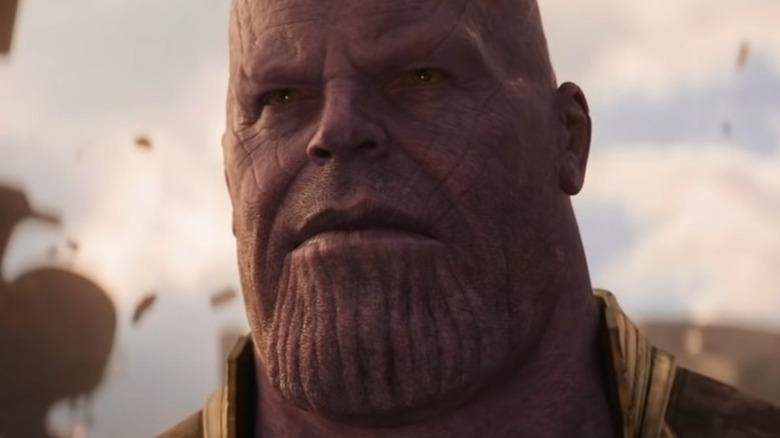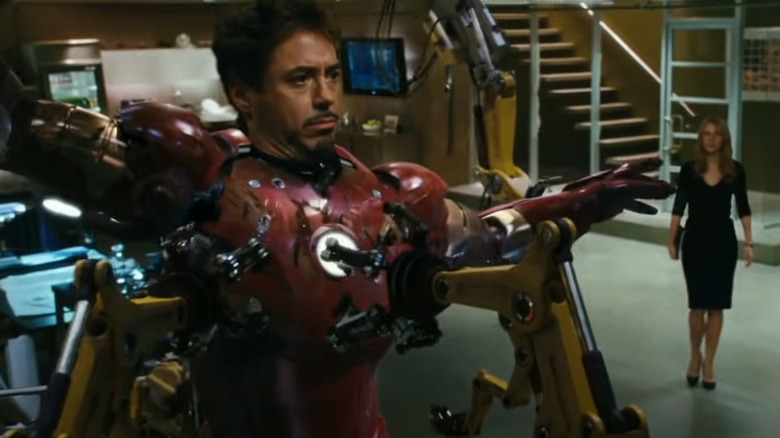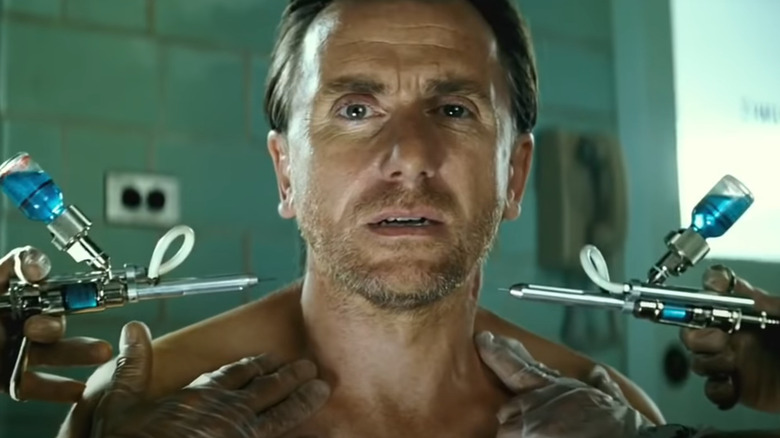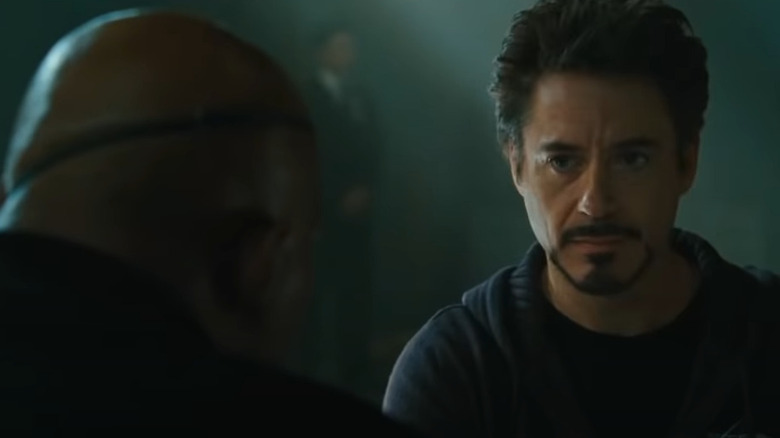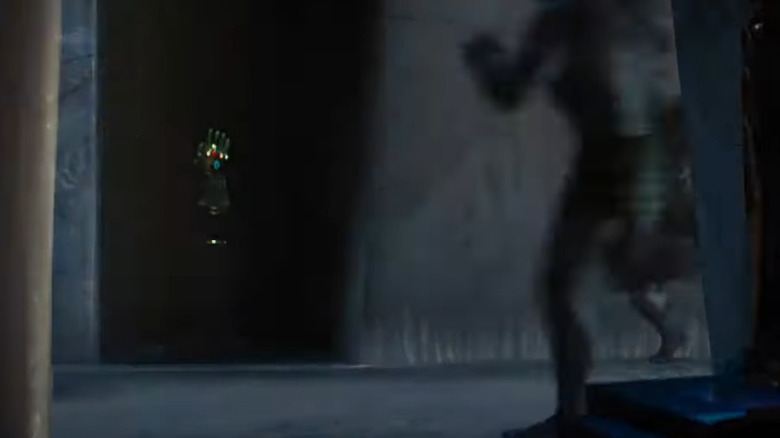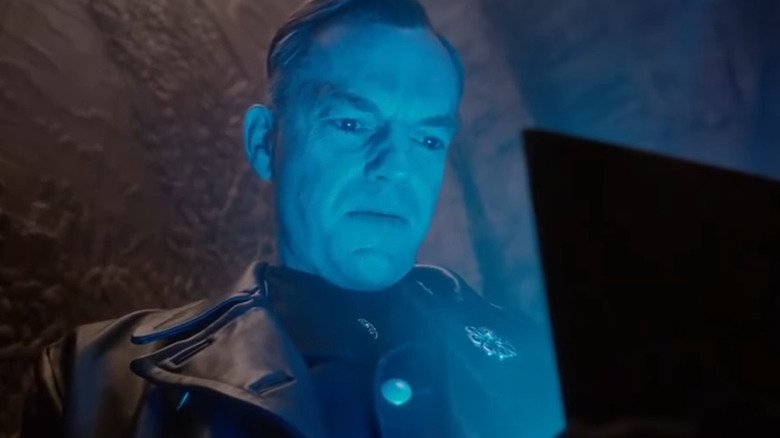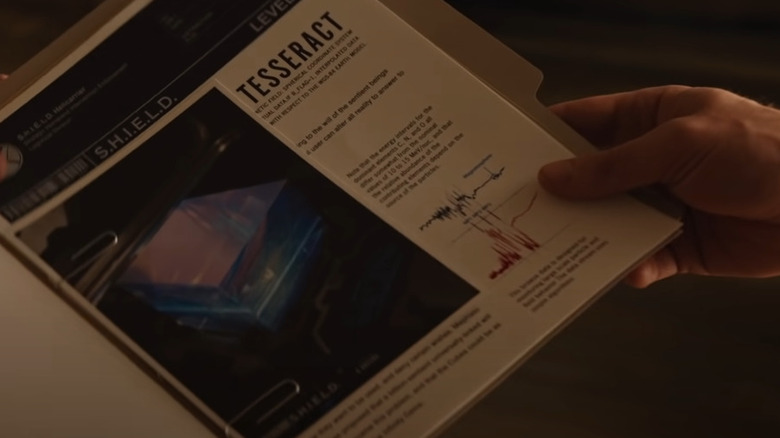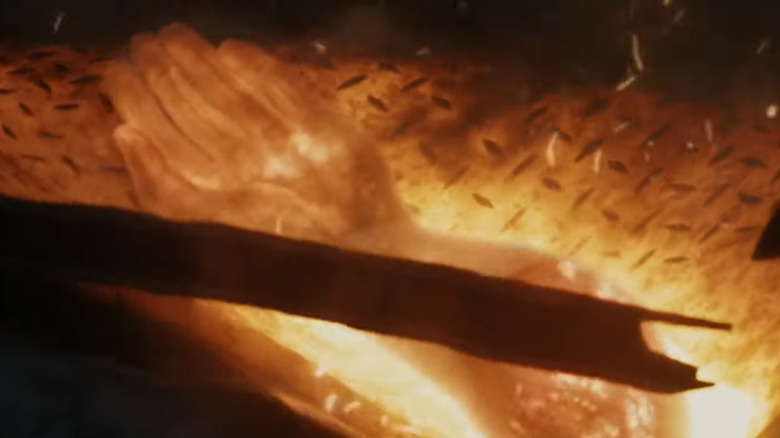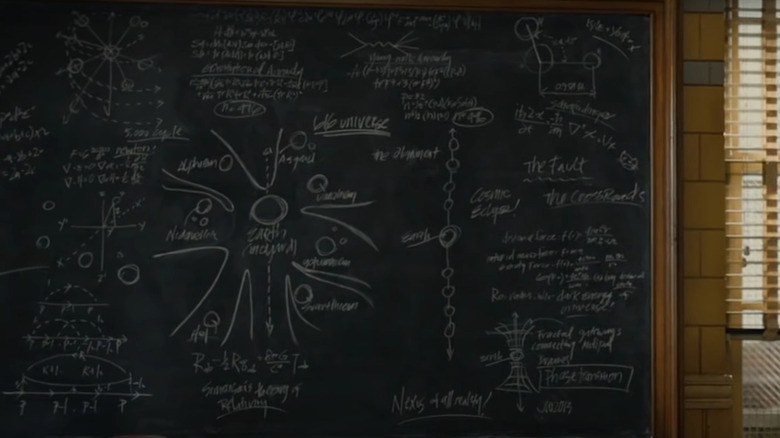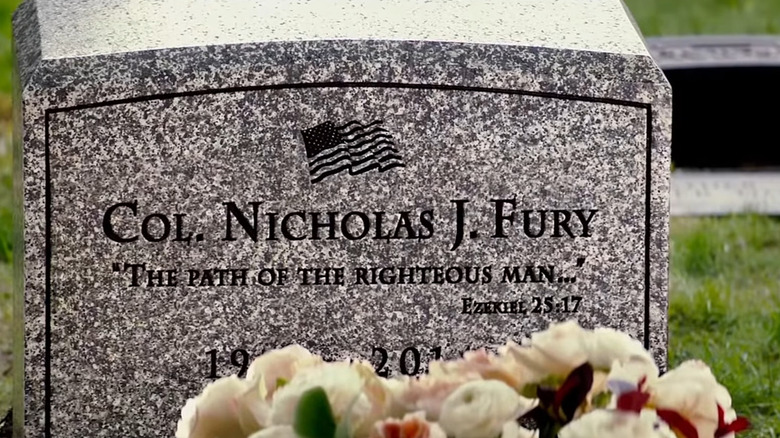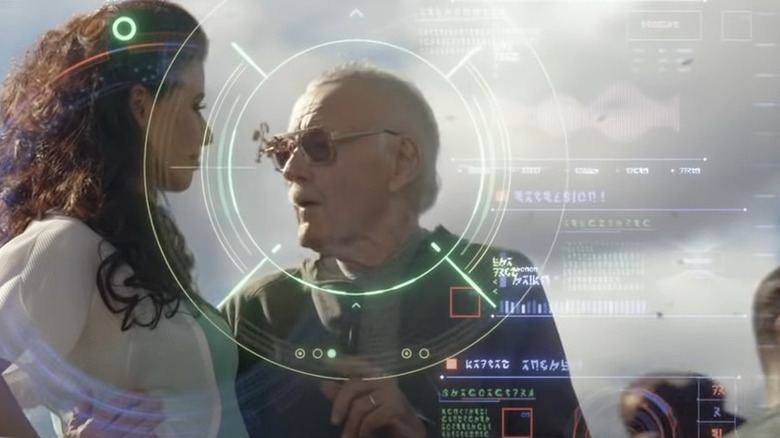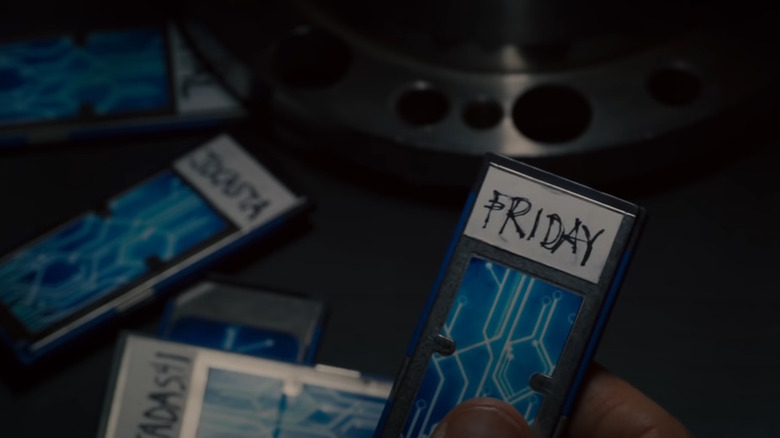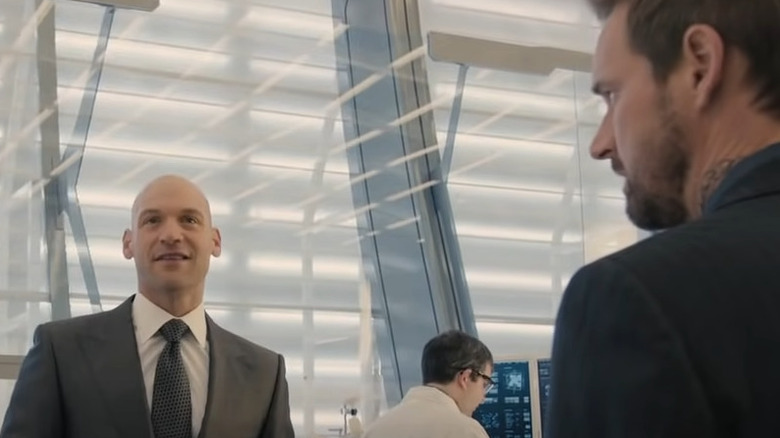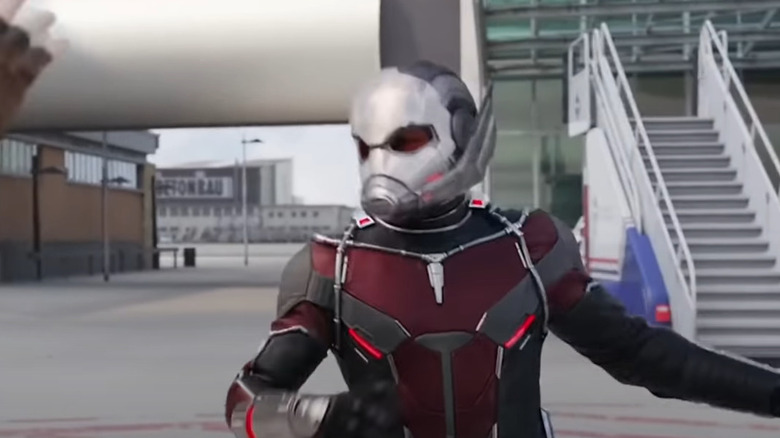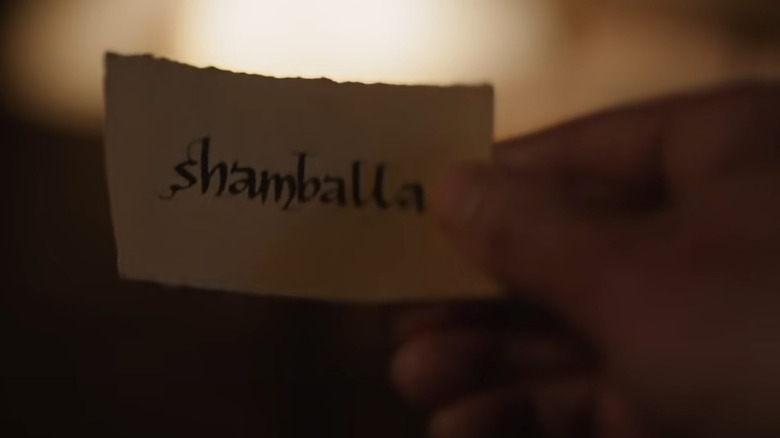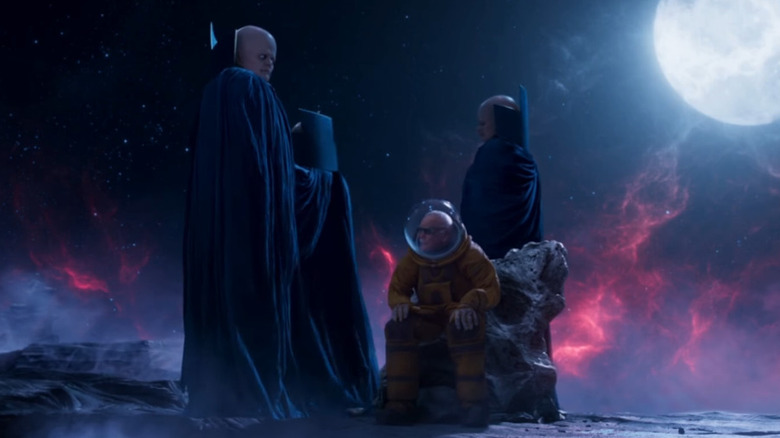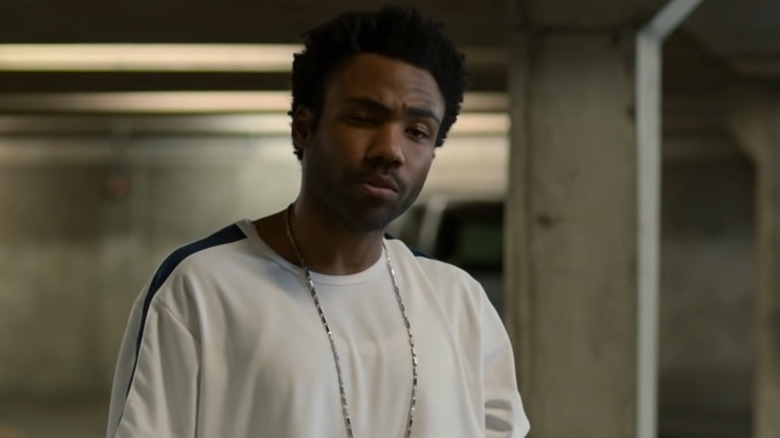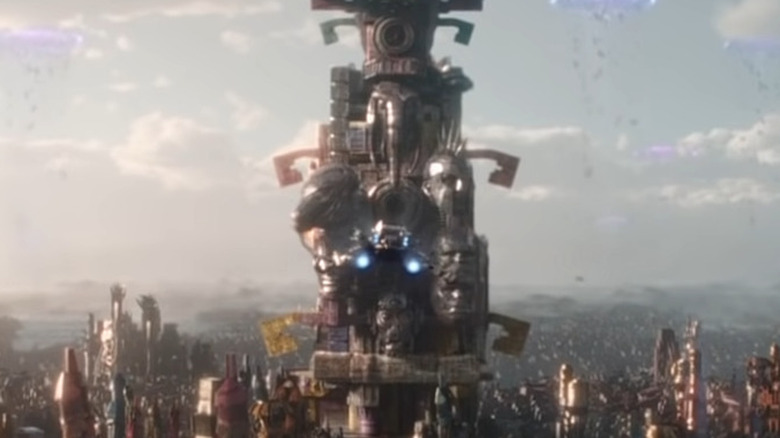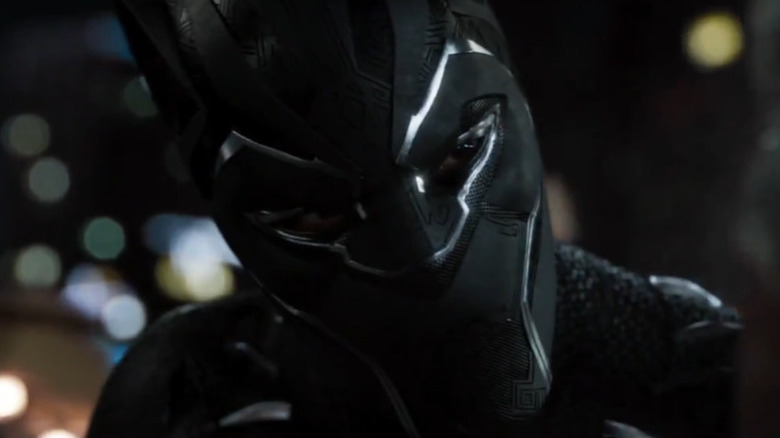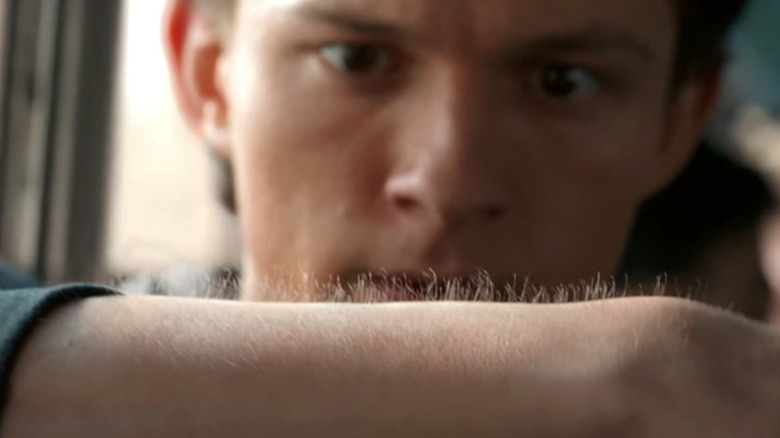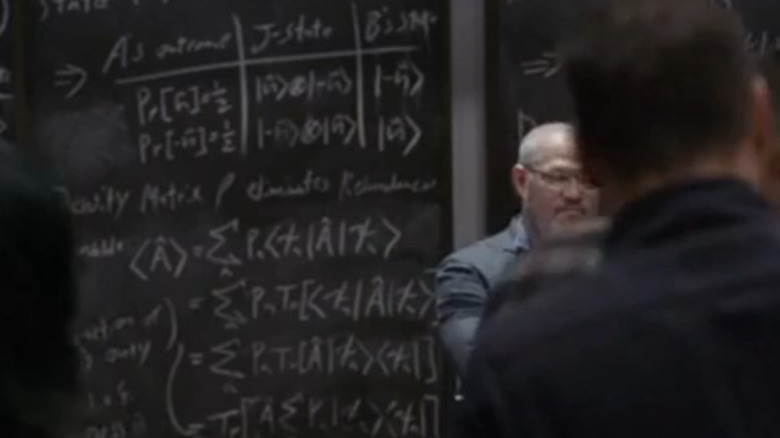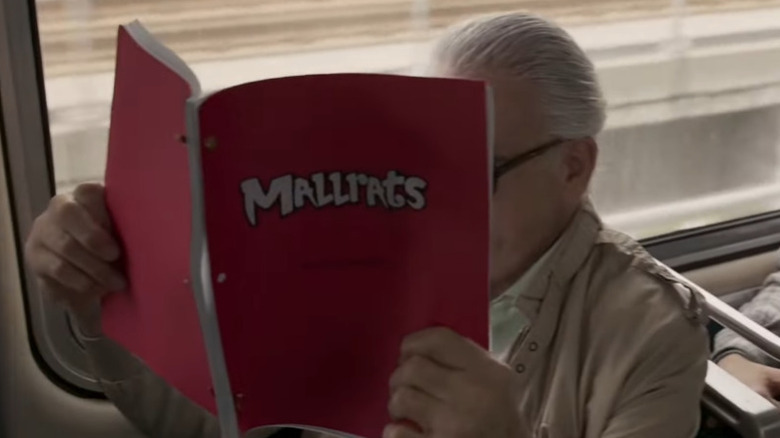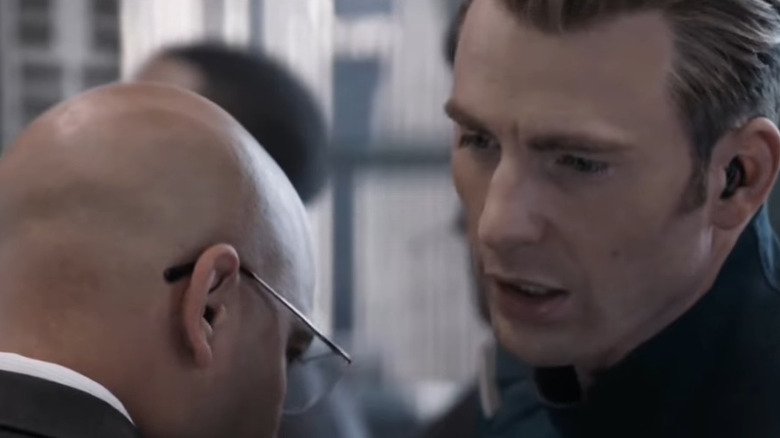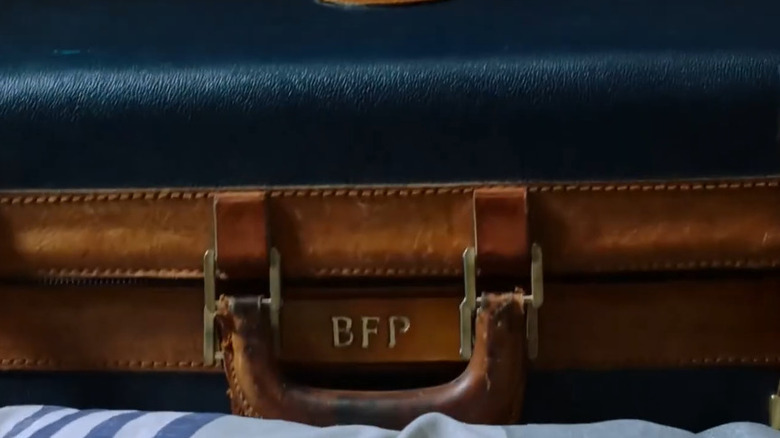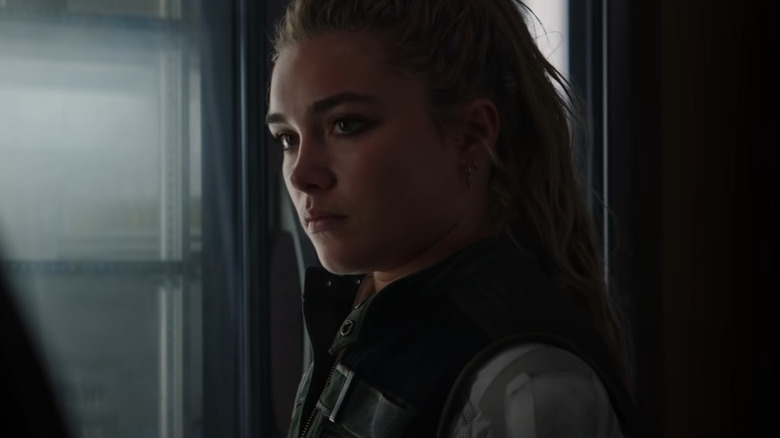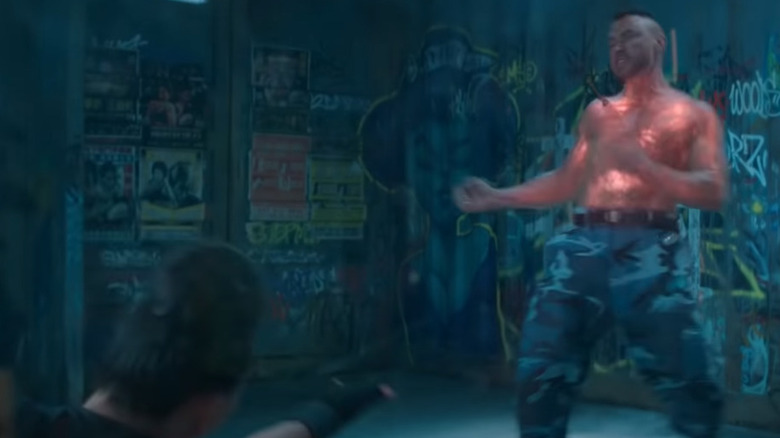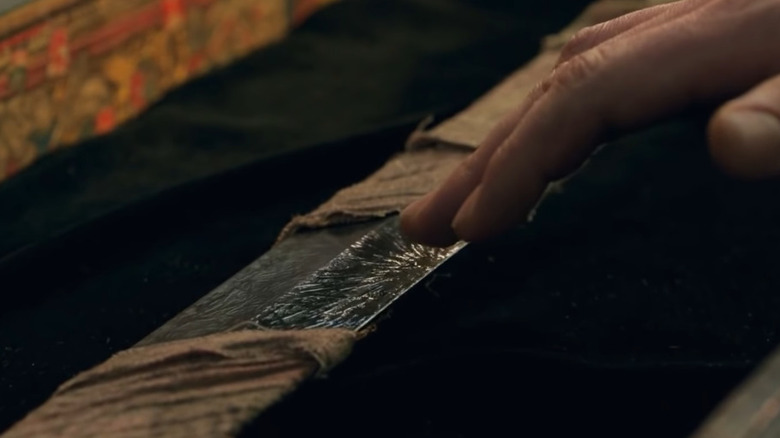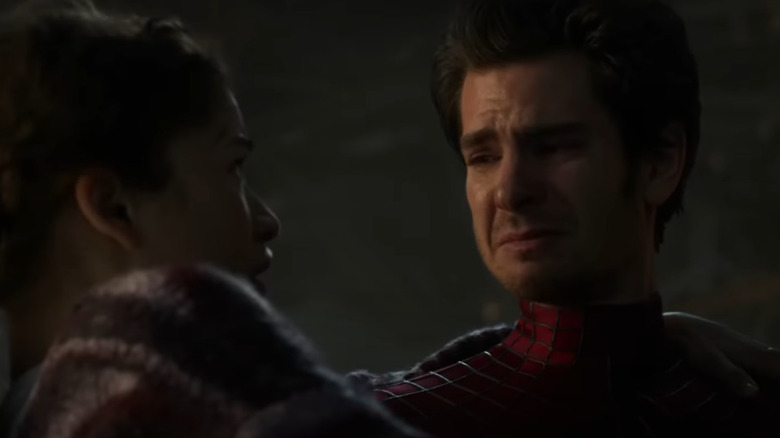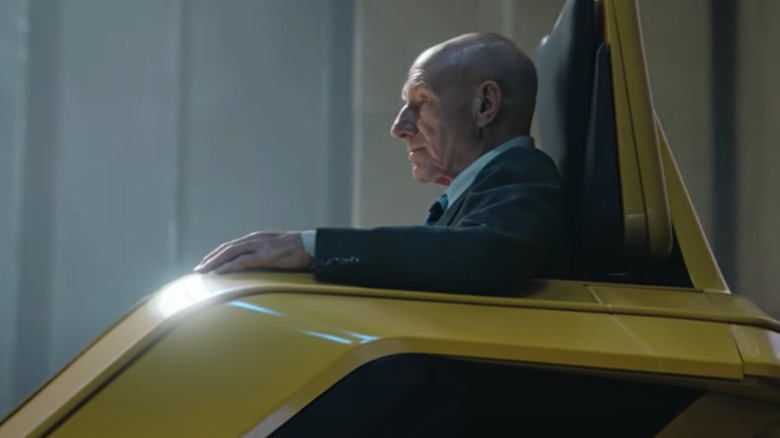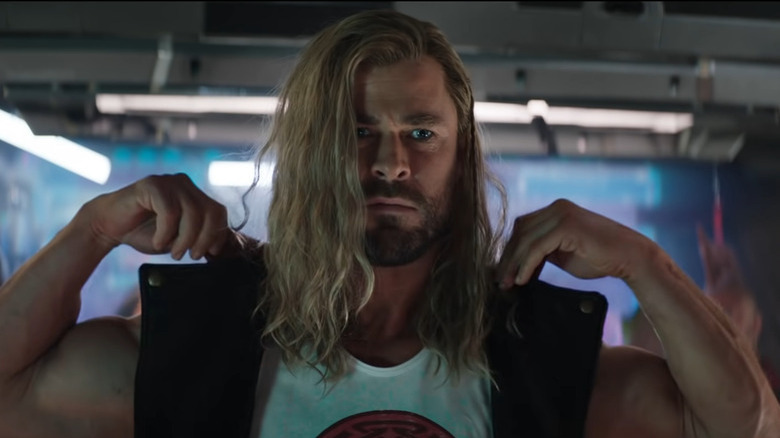The Best Easter Egg In Every MCU Movie
With over a decade's worth of movies and a staggering number of characters under its belt, it's no surprise that the Marvel Cinematic Universe remains the highest-grossing film franchise of all time. According to numbers from Statista, the movie series has raked in over $26 billion worldwide as of 2022 — and with more connected movies and TV shows on the way, this multibillion-dollar juggernaut is showing no signs of slowing.
A big part of what makes the MCU so successful is that its films have something to offer for new audiences and longtime comic readers alike. Ever since the one-eyed Nick Fury (Samuel L. Jackson) visited Tony Stark (Robert Downey, Jr.) at the end of 2008's "Iron Man" to talk to him about "the Avenger Initiative" — a brief appearance that wasn't even originally intended to start any sort of wide-scale universe building involving the S.H.I.E.L.D. director, per ComicBook.com — fans have looked forward to watching every new MCU film, not just for the action-packed stories and witty banter, but also for the little references, surprises, and cameos sprinkled throughout.
Indeed, MCU movies tend to be filled to the brim with so many Easter eggs that it's tough to list them all down — and an even bigger challenge to identify the best one. That said, some are just more special (or satisfying) than others. Here's a list of what we think are the best Easter eggs from the 29 MCU films released so far. Spoilers ahead.
Captain America's shield in Iron Man
Hindsight's a funny thing. Knowing how successful the MCU has become over the years, it's quite surreal to look back at the early films within the cinematic continuity and think that they weren't destined for box office domination. But that's exactly how it was with 2008's "Iron Man," a largely improvised production described by Digital Spy as "a huge gamble that could have easily brought [Marvel] to ruin."
It was the (mostly) unexpected success of "Iron Man" that gave the entertainment company the boost it needed to rise above decades-long stagnation. That said, it also helped that the filmmakers sneaked in little references here and there to a larger universe, despite its uncertain future at the time. And of course, said references include a scene that eagle-eyed audiences caught (and one that was slyly left out of the official trailers) — the shield of World War II hero Captain America, partially constructed and sitting idly on Tony Stark's work desk.
In a 2010 interview with MTV, director Jon Favreau (who also portrays Tony's head of security, Happy Hogan) explained that the movie's inclusion of the iconic discus was nothing more than a visual gag, at least at first. "An [Industrial Light and Magic] artist put it in there as a joke to us for our cineSync sessions, when we're approving visual effects," Favreau explained. They liked it enough that they kept it in the film's final cut and even acknowledged it in "Iron Man 2."
The Incredible Hulk also references Captain America
2008's "The Incredible Hulk" is a bit of an oddity, with some even questioning whether it's really part of MCU canon (it definitely is). However, a full viewing of the film would be more than enough to settle any questions about its place in the cinematic universe. For starters, the late William Hurt reprised his role as Gen. Thaddeus "Thunderbolt" Ross in other MCU projects. Robert Downey Jr's Tony Stark even showed up in the post-credits stinger. The most interesting MCU connection in the film, however, was a blink-and-you'll-miss-it reference that requires both a quick eye and comic book knowledge to fully appreciate.
In the movie, Emil Blonsky (Tim Roth) receives a special serum that transforms him into the Abomination, a monster intended to be the Hulk's physical match. The container holding the serum bears a label attributing its development to a certain Dr. Reinstein, a name familiar to longtime "Captain America" readers. "Dr. Reinstein" was actually a fake name used by Dr. Abraham Erskine, the man who developed the Super Soldier formula that turned the scrawny Steve Rogers (Chris Evans) into America's mightiest champion.
Interestingly, the final cut of "The Incredible Hulk" could have featured more than a passing reference to the Captain, had things turned out the way director Louis Leterrier originally intended. A deleted scene actually included a cameo of the Star-Spangled Avenger's frozen body, preserved underneath the Arctic ice.
Iron Man 2 hints at Black Panther's existence
Part of the fun in watching MCU movies lies in finding all the little ways they plant the seeds for future projects. By the time "Iron Man 2" rolled into theaters, it was already clear that there was a bigger plan for the universe that these versions of Tony Stark and Nick Fury inhabit. Aside from introducing new heroes Black Widow (Scarlett Johansson) and War Machine (Don Cheadle, taking over Terrence Howard's role in the previous film), it also delved deeper into the Avengers Initiative, exploring how it would be executed while emphasizing that (at that point in time, at least) Stark would not be a good addition to the project. Interestingly, the scene where Fury delivers the not-so-good news to Stark contains an early reference to the existence of a hero who would eventually fight alongside the Avengers: The Black Panther.
The sequence features the two men sitting down in a covert location and discussing Black Widow's assessment of Stark. Beside Stark and Fury are some S.H.I.E.L.D. holographic screens that depict a map of the world, with certain locations marked. One of the markers seemingly references Atlantis, the domain of longtime Marvel character Namor the Sub-Mariner (though fans didn't read much into this, given the character's complicated movie rights at the time). The marker that certainly got a lot of attention, though, is one that pointed to a seemingly secret location in Africa: The technologically advanced, Vibranium-rich nation of Wakanda.
Thor features the Infinity Gauntlet (sort of)
After three largely grounded movies, Marvel Studios' fourth offering, 2011's "Thor," took fans to an entirely new place. Following the origin story of the eponymous, Mjolnir-wielding Avenger, "Thor" introduced audiences to the fantastic realm of Asgard. It also featured a short but sweet glimpse at a very important object in the MCU: The Infinity Gauntlet. (Well, not the Infinity Gauntlet, but still.)
In the scene where Thor (Chris Hemsworth) is proclaimed by his father Odin (Anthony Hopkins) as Asgard's next king, we see their sworn enemies, the Frost Giants, making their way through the palace walls and into the vault where precious artifacts are kept by the All-Father. Seeking to obtain the Casket of Ancient Winters (a powerful relic that used to be in the Frost Giants' possession), they struck a deal with Thor's trickster brother Loki (Tom Hiddleston) that allowed them to sneak into the palace undetected. However, when the invaders attempt to take the relic, the Destroyer (a gigantic, automated suit of armor serving as the vault's guardian) comes to life and goes after them. In the chaos that follows, the Gauntlet is shown for a few seconds on screen.
However, as Hela casually revealed in 2017's "Thor: Ragnarok," the Gauntlet in Odin's vault was a counterfeit. This throwaway line of dialogue was meant to address a massive plot hole that was created when 2015's "Avengers: Age of Ultron" showed the Gauntlet in the possession of Thanos all along.
Captain America: The First Avenger pays homage to Indiana Jones
After all the little clues sprinkled in previous films, fans finally got to see Steve Rogers (Chris Evans) in action in 2011's "Captain America: The First Avenger." Set during the Second World War, it told the tale of how a scrawny, bullied kid from Brooklyn was gifted with a superhuman physique to match his superheroic heart. Initially deemed too expensive and risky to send out into actual combat, Captain America soon took the lead in fighting Hitler's men, placing him in direct conflict with one of the Fuhrer's most fearsome lieutenants: Johann Schmidt, aka the Red Skull (Hugo Weaving).
Wait a minute — an American adventurer in an iconic costume going up against German forces? If that sounds familiar to you, perhaps you've seen "Raiders of the Lost Ark." And in case it doesn't ring a bell, there's a line of dialogue uttered by the Red Skull that's meant to remind you of that classic Indiana Jones flick. Early on in "Captain America: The First Avenger," the Red Skull finds and seizes a blue cube of immense power called the Tesseract from a town in Norway. As he first lays his eyes on the glowing artifact, the Red Skull mockingly mentions how the Fuhrer is busy digging "for trinkets in the desert" at that moment. Avid moviegoers will likely draw the connection between this line and Hitler's quest to find the Ark of the Covenant in "Raiders."
The Avengers references a demonic Marvel character
There's a scene in 2012's "The Avengers" that was used as the post-credits stinger for "Captain America: The First Avenger" a year earlier. The sequence in question features the Captain awake in the present day, after being frozen in the Arctic ice for decades. As he's training all alone at the gym, Fury shows up with a briefing and an invitation: He hands Rogers a document containing intel about the Tesseract, and asks him to join the Avengers Initiative to fight in a brewing, brand new war. While Fury's papers contain important information about the cube, it's the name of the agent who prepared it that makes it even more fascinating than it already is, at least for comic book fans.
Upon closer inspection of the first page of the document, the name Mephisto is in the caption under the photo of the Tesseract. This codename appears to refer to the S.H.I.E.L.D. operative who helped the agency acquire data about the powerful artifact. However, some speculated that this was a reference to the Marvel comics demon of the same name, a malevolent, extradimensional force who uses mystical means and trickery to cause all sorts of mayhem in the Marvel universe. Over time, Mephisto became an in-joke among MCU fans because of all of the debunked conspiracy theories about the demon's supposed involvement in the events of "WandaVision." But hey, at least we can say that the MCU technically does have a Mephisto, kinda.
Iron Man 3 had a hand in starting an MCU movie trend
When "Iron Man 3" premiered in 2013, it kicked off Phase Two of the MCU. It also started a trend among all the Phase Two movies — one that was allegedly unintentional at first, but was eventually acknowledged by Marvel Studios president Kevin Feige.
During the battle between Iron Man and the Extremis-enhanced Aldrich Killian (Guy Pearce), Stark manages to lop off Killian's left hand to stop the latter from killing him. In "Thor: The Dark World," Loki casts an illusion that makes it appear that he chopped off Thor's hand in order to trick the Dark Elves. In "Captain America: The Winter Soldier," Rogers' best friend Bucky Barnes (Sebastian Stan) resurfaces as the titular villain, with his entire left arm missing and replaced with a cybernetic appendage. In "Guardians of the Galaxy," Groot (Vin Diesel) loses both arms (which quickly regenerate) because of Gamora (Zoe Saldana), while Ulysses Klaue (Andy Serkis) gets his arm swiftly chopped off by Ultron (James Spader) in "Avengers: Age of Ultron." Lastly, in "Ant-Man," when Scott Lang (Paul Rudd) disables the Yellowjacket suit with Darren Cross (Corey Stoll) still inside it, the villain's right arm (painfully) shrinks first before the rest of him does.
In an interview with CinemaBlend, Feige (a self-professed "Star Wars" geek) confirmed that the phase-wide Easter egg was a nod to "Star Wars Episode V: The Empire Strikes Back." He said: "It didn't start out as intentional, but it became intentional."
Dr. Selvig's reference-filled chalkboard in Thor: The Dark World
2013's "Thor: The Dark World" may not have been the strongest film from the MCU's Phase Two slate, but it did feature some important developments in the Thunder God's relationship with his brother, as well as some neat references to both the movie universe and the comic book universe that inspired it.
In one scene, there's a chalkboard full of notes from Dr. Erik Selvig (Stellan Skarsgård) and Dr. Jane Foster (Natalie Portman) related to the possible destruction of Earth due to the cosmic event called the Convergence. Eager fans noticed that the board contained references to real-world science and Thor's comic book lore. The book "Thor: The Dark World – The Art of the Movie," released in the same year, has a "laymanized" list of the items on the board (via ComicBook.com).
The chalkboard mentions phenomena related to black holes, how matter changes from one state to another, electromagnetic forces, and even string theory. It also has some terms that comics readers would doubtlessly recognize, such as "616 universe" (the official designated number for the mainstream Marvel universe continuity, as established in 1983's "Daredevils" Vol. 1 #7), the Nexus of All Reality (the occasional point of intersection of parallel worlds, as seen in 1973's "Fear" Vol. 1 #13), and the Crossroads (a "gateway dimension consisting primarily of portals to other worlds" that was notably featured in 1984's "Incredible Hulk" Vol. 1 #300).
Captain America: The Winter Soldier contains a nod to Pulp Fiction
The critically acclaimed sequel "Captain America: The Winter Soldier" came out in 2014 and introduced some significant, world-shaking changes to the expanding MCU. For starters, it features Captain America's best friend Bucky — who was thought to have died decades earlier — as the deadly shadow operative known as the Winter Soldier. The film also contains the first appearance of the Falcon (Anthony Mackie), the man who would succeed Steve Rogers as Captain America years later. Perhaps most importantly, it reveals the sinister truth behind S.H.I.E.L.D., which had become infested with Hydra agents. Nick Fury even has to fake his death (complete with a grave and headstone) so he can continue to work behind the scenes and bring down the corrupted agency.
The Biblical passage engraved on his tombstone — "The path of the righteous man..." ascribed to Ezekiel 25:17 — will no doubt be familiar to longtime fans of Samuel L. Jackson: It's part of his dialogue in one of the most iconic sequences from the famous 1994 crime film "Pulp Fiction." In an interview, directors Joe and Anthony Russo shared that they decided on Fury's epitaph following the suggestion of the film's effects supervisor, Dan Deleeuw. Interestingly, according to The Independent, the veteran actor "still knows the full passage, but struggles to remember a single line of dialogue he had in 'The Winter Soldier.'"
Guardians of the Galaxy featured an alien take on a famous catchphrase
For a brief period of time, there was speculation that Stan Lee, who famously cameoed in most Marvel movies, would not show up in 2014's "Guardians of the Galaxy" due to the fact that he didn't have a hand in their creation (via Yahoo!). "I didn't write 'Guardians of the Galaxy,'" Lee stated in an interview, adding that he was "not even sure who they all are!" That's why fans were delighted when the film's final cut did in fact contain a cameo from The Man himself, complete with his signature line "Excelsior" flashed on the screen in a made-up alien language.
According to Inverse, a Twitter user spotted the Easter egg in a scene on Xandar, the home base of the Nova Corps. Lee and the alien "Excelsior" script appear when Rocket Raccoon (Bradly Cooper) uses a sophisticated gadget to identify the individuals around him and Groot to find their next target. However, this was actually not the original plan for Lee's cameo (per Digital Spy). In an interview with director James Gunn, he confirmed that initially, Lee was supposed to be a specimen in the treasure room of the Collector (Benicio del Toro), and was supposed to throw a rude gesture at Groot. Gunn also said that he decided to scrap the cameo from the film on his own, and that it wasn't a studio mandate as rumored.
The A.I. assistants that could have been in Avengers: Age of Ultron
2015's "Avengers: Age of Ultron" confirmed what many audiences probably already knew about Tony Stark: He had contingency plans in place if the technology he frequently relied on ever got disabled or compromised. Following the transfer of his previous A.I. assistant JARVIS into the synthezoid body of the Vision (Paul Bettany), Stark was in need of a replacement. Searching through a small collection of program cards, Stark picks out FRIDAY, which becomes his new guidance system. However, fans also caught a glimpse of some of the program cards that Stark didn't select — and two of them bore names that were quite familiar to Marvel comics fans.
One of the cards was labeled "JOCASTA," which longtime readers of the Avengers' comic book exploits would know is the name of the A.I.-powered robot that was built by Ultron to be his partner. She ultimately turned on the genocidal villain, though, and even joined the Avengers as well. Meanwhile, another card bore the name "TADASHI," a reference to the character Tadashi Hamada, the inventor of the A.I. program behind the healthcare-robot-turned-superhero Baymax in the animated Disney film "Big Hero 6" (which was also inspired by an existing Marvel property).
Ant-Man and a tattoo of the Ten Rings
The clandestine organization known as the Ten Rings has been an established threat in the background of the MCU since "Iron Man," with subsequent films gradually revealing more information about the fearsome criminal group. However, what many fans may not know is that in 2015, "Ant-Man" nearly featured a blink-and-you'll-miss-it reference to the terrorist faction in its final cut.
In a commentary track for the film, "Ant-Man" lead Paul Rudd and director Peyton Reed spill the beans on a short scene that was omitted from the movie (via CinemaBlend). After Pym Technologies CEO (and eventual villain Yellowjacket) Darren Cross was able to unlock the shrinking secrets of Pym Particles, he immediately invited a group of prospective buyers to a demonstration at the company. In the deleted scene, a tattoo of the Ten Rings was partially visible on the neck of one of the potential investors, implying that he was actually a member and that the group wanted to get its hands on the shrinking technology.
The Bluth stair car in Captain America: Civil War
MCU Easter eggs don't always have to play an important role in the greater scheme of the films' shared continuity, nor do they always have to make sense within the context of the movies they're in. Heck, they don't even need to be related to the Marvel brand at all. Just ask Joe and Anthony Russo, the directors of 2016's "Captain America: Civil War," who added one of the most unexpected (and comically out of place) references you'll find in any MCU film.
During the big showdown between Team Cap and Team Tony at the Leipzig-Halle airport in Germany, there's a scene where Ant-Man and Captain America use Pym Particles to turn a miniaturized vehicle into an expanding projectile. For a few seconds, we get a glimpse of a unique vehicle that should be instantly recognizable to fans of the sitcom "Arrested Development" — the Bluth Company stair car, sans the company's logo on the side. There's a good reason for this Easter egg: As Business Insider explains, the Russo brothers actually directed the pilot of "Arrested Development" (plus a few episodes of the series) years before they got into the business of directing MCU films.
As fans of the show would attest, the Bluth family car wasn't exactly known for being a smooth ride, and was even used in a few wacky situations. Let's just be thankful that it didn't cause either side of the superhero Civil War any trouble.
The hilarious truth of Shamballa in Doctor Strange
"Doctor Strange," the second film in the MCU's Phase Three, featured a simple but clever gag that was even used in the film's trailer. When Stephen Strange (Benedict Cumberbatch) arrives at the mystical sanctuary Kamar-Taj in search of the Ancient One (Tilda Swinton), her student Mordo (Chiwetel Ejiofor) hands Strange a piece of paper with the word "Shamballa" on it. The bewildered outsider asks what it's for, instantly assuming that it is some sort of magical incantation. Mordo's response? "It's the WiFi password. We're not savages." And of course, because this is a Marvel movie, you can bet that there's an interesting meaning behind it.
Published in 1986, the 23rd issue of the "Marvel Graphic Novel" series features a story called "Doctor Strange: Into Shamballa." The book follows Dr. Strange as he travels to the Ancient One's homeland in the Himalayas to honor his fallen master. Upon his arrival, he discovers that his mentor left a peculiar gift for him there, a box that seems to be impossible to open. This leads to an unexpected adventure for the Master of the Mystic Arts, who eventually arrives at a magical moral quandary. We won't spoil the rest of the story for you, so that you can read it for yourself (and appreciate the book's beautifully illustrated pages).
The Man is watching in Guardians of the Galaxy Vol. 2
There was a time when a Marvel movie viewing experience wasn't complete without spotting a cameo from Stan Lee. His appearances in numerous adaptations of Marvel properties led some fans to theorize that there was a connection between them. If you've ever wondered about this yourself, the Stan Lee cameo in 2017's "Guardians of the Galaxy Vol. 2" has a pretty neat answer for you.
When we see The Man, he's wearing a spacesuit and sitting on an asteroid. He's not alone, though, as three Watchers — yep, those tall, hairless space voyeurs in flowy robes — are listening to him talk about other adventures (read: his Marvel cameos). In other words, as one Twitter user (via Digital Spy) put it: "Stan Lee was canonically a Watcher informant, and was playing the same character in every MCU movie." Director James Gunn responded to this tweet by admitting that "fan theories on Twitter" were what prompted him to shoot this lighthearted Stan Lee scene. Kevin Feige himself acknowledged (via Den of Geek) that the late Marvel legend "clearly exists above and apart from the reality of all the films."
That said, as cool as it is, this scene did create a bit of a continuity gaffe. Lee mentioned being a FedEx delivery man, which was his cameo in "Captain America: Civil War," a film that supposedly took place after this one. To his credit, Gunn acknowledged the error.
Spider-Man: Homecoming teases Peter Parker's protégé
There's a scene in 2017's "Spider-Man: Homecoming" where Peter Parker (Tom Holland) makes use of voice-changing Stark technology to sound more intimidating during an interrogation attempt. Hilariously, it doesn't work on his target: Aaron Davis (Donald Glover), a small-time weapons dealer working out an arrangement with the Vulture (Michael Keaton) and his men. Davis and Spider-Man engage in a bit of banter, and when the superhero gets the information he needs, he leaves the thug webbed to the trunk of his car.
This sequence is special for two reasons. It teases the existence of another (possible future) Spider-person, and it's the culmination of a seven-year-old campaign to put Donald Glover in a "Spider-Man" movie. Davis is, of course, the uncle of Miles Morales, aka the Spider-Man from the Ultimate universe (Earth-1610) who now occupies the main Marvel Earth (616). While the MCU's Davis doesn't say Morales' name, he does mention that he has a nephew, which is more than enough confirmation.
Back in 2010, when the Marc Webb-helmed "Spider-Man" reboot was announced, the hashtag #donald4spiderman went viral on Twitter as Glover's fans pushed for him to be considered for the lead role. Andrew Garfield was eventually cast as the webslinger. Years later, "Spider-Man: Homecoming" director Jon Watts (a longtime fan of the "Community" star) swore to find a way to include Glover in his Spider-film — and the rest, as they say, is history.
Thor: Ragnarok pays tribute to fan-favorite Marvel characters
Taika Waititi's take on Thor in 2017's "Thor: Ragnarok" was a radical departure from the tone established in the previous films. It was a refreshing tonal shift, one welcomed by fans and critics. "Thor: Ragnarok" also excels when it comes to paying homage to the source material — there's quite literally a monumental nod to some beloved comic book characters we have yet to see in the MCU.
In "Thor: Ragnarok," Thor finds himself trapped on the waste planet Sakaar. He becomes an unwilling participant in the Contest of Champions, a series of brutal battles organized by the Grandmaster (Jeff Goldblum) for his own amusement. The Grandmaster honors previous victors by adding their sculptures on the tower of his palace, which already has a few familiar faces on it. Eagle-eyed fans will have noticed the faces of the mystical guardian the Man-Thing, the war god Ares, and the Hulk villains Bi-Beast and Dark-Crawler on the tower. The most significant face there belongs to none other than Beta Ray Bill, a horse-faced, genetically modified member of the Korbinite race and ally of Thor in the comics who wields the powerful weapon Stormbreaker.
Kevin Feige revealed that Beta Ray Bill originally had a slightly bigger (but not big enough) role in "Thor: Ragnarok," which led to him being cut from the film. "The feeling is, if you can't do [a character like Beta Ray Bill] justice, do it later," he told Crave Online (via ComicBook.com).
Black Panther features a line straight from the comics
Introduced in 2016's "Captain America: Civil War," T'Challa (portrayed by the late Chadwick Boseman) instantly endeared himself to fans as the agile superhero Black Panther. Two years later, the character starred in a solo movie, which received much critical acclaim (and even recognition at the Oscars). While "Black Panther" successfully fleshed out the mythos of Wakanda and its citizens, it also had a line of dialogue referencing Black Panther's bitter feud with a character that audiences have yet to meet in the MCU: Namor the Sub-Mariner.
When T'Challa successfully subdues Ulysses Klaue after a long chase, the villain begs for mercy from the Wakandan king, to which the superhero responds, "Every breath you take is mercy from me." It's an awesome line that, unbeknownst to many moviegoers, is actually taken from 2014's "New Avengers" Vol. 3 #22, in which T'Challa says it to Namor. Way before that issue, T'Challa already had a major ax to grind with the arrogant Atlantean king, because Namor once caused tremendous suffering and death to many Wakandans as a result of what could charitably be called a "petty grudge."
By the time the two kings found themselves on the same team (the Illuminati), their animosity had already reached boiling point, leading to a brutal confrontation — and Namor's abrupt departure from the team.
Avengers: Infinity War unlocks a classic Spider-Man power
While audiences were happy to see Spider-Man become formally integrated into the MCU with the release of "Spider-Man: Homecoming," the apparent absence of his famous spider-sense throughout the film became a serious point of contention. In a 2017 interview with Collider, "Spider-Man: Homecoming" director Jon Watts explained the decision to make the spider-sense less of a presence in his film. "The idea was, again, just you want to make this movie be less about things you've already seen before, and you've definitely already seen a spider-sense sequence done extremely well in Marc [Webb]'s and [Sam] Raimi's movies," he said.
Despite Kevin Feige's confirmation (via IGN) that the MCU version of Peter definitely possesses a spider-sense and that they would "explore it further down the line," fans still eagerly awaited the day they'd witness this version of the webslinger's internal danger sensor in action. That day came in 2018's "Avengers: Infinity War." When the forces of Thanos (Josh Brolin) make it to Earth in search of the Infinity Stones, Peter is with his classmates on a Midtown school bus. The young superhero is immediately alerted to the strange happenings in his typically friendly neighborhood when he feels the hairs on his arms standing. He then prompts his best friend, Ned Leeds (Jacob Batalon), to come up with a distraction, giving him the opportunity to exit the bus, don his Spider-Man suit, and swing into action.
Ant-Man and the Wasp features a reference to The Matrix
After the world-shattering events of "Avengers: Infinity War," MCU fans were treated to a lighthearted follow-up of sorts with the release of "Ant-Man and the Wasp." While most of the film explores Scott's life under house arrest following his participation in the battle at the Leipzig-Halle airport, it also introduces another size-changing superhero from the comics: Dr. Bill Foster (Laurence Fishburne), aka Goliath.
The movie doesn't really show Foster engaging in superheroics the same way Ant-Man and the Wasp (Evangeline Lilly) do, but it does mention his time working with Dr. Hank Pym (Michael Douglas) as a S.H.I.E.L.D. scientist, as well as the fact that he once used Pym Particles to grow up to 21 feet tall. In the scene where Dr. Foster is shown lecturing to a classroom full of students, the chalkboard behind him is full of mathematical equations. It also has the word "matrix" written on it, which, while a perfectly appropriate word for the situation, can also be interpreted as a reference to Fishburne's iconic role as Morpheus in "The Matrix."
Now, here's a neat bit of synchronicity: Per writer Neil Gaiman's recollection, Fishburne's portrayal of Morpheus in "The Matrix" was directly inspired by the character of the same name from Gaiman's "Sandman" comics. Prior to the release of "The Matrix," Warner Bros. contacted Gaiman, seeking his help to promote the film. Gaiman then wrote a short story inspired by the film, called... "Goliath."
Stan Lee reads a script on the train in Captain Marvel
Marvel legend Stan Lee was able to film a few extra cameo appearances for a handful of then-upcoming Marvel movies before his death in 2018. One such Easter egg was for 2019's "Captain Marvel." During the sequence where Carol Danvers (Brie Larson) searches for a Skrull agent hiding among passengers of a transit train in Los Angeles, she briefly encounters Lee sitting by one of the windows. The comic book writer is shown reading the script for the 1995 film "Mallrats," which he also appeared in. We hear him reading one of his lines from the movie out loud ("Trust me, true believer"), after which he and Danvers exchange friendly glances.
Speaking to The Hollywood Reporter, "Mallrats" director and unabashed comic book geek Kevin Smith expressed his delight at the nature of Lee's cameo in "Captain Marvel," and how it referenced his film. "It was really kind of poetic and to hear him saying his line, which, to be fair, was some s*** that he would say in real life all the time: 'Trust me, true believer.' It was everything." Smith must have been thrilled by the fact that this was basically confirmation that a version of him exists in the MCU.
Avengers: Endgame references a controversial comic book story
2019's "Avengers: Endgame" is a grand payoff to a decade's worth of storytelling and world-building. The film ties up many (but not all) loose ends from various MCU productions and gives a few of its most beloved superheroes fitting send-offs. It's also notable for rewarding longtime fans with a massive battle sequence that can only be described as epic. One of the best things about the film is the way the main characters are able to revisit some of their most iconic moments — in the case of Steve Rogers, his visit to the past allowed him to play things a bit smarter in a situation very similar to that elevator fight scene from "Captain America: The Winter Soldier."
This time, instead of beating up an elevator full of well-trained covert Hydra agents (and demonstrating exactly what a super-soldier can do in cramped quarters), Rogers is able to bypass a violent confrontation in his quest to obtain Loki's scepter from Agent Jasper Stillwell (Maximiliano Hernández). He simply whispers "Hail Hydra" in the agent's ear. This works, and Rogers is seen seconds later exiting the elevator with the scepter in tow.
While this scene doubtlessly calls back to Cap's elevator fight, it's also a sly reference to a controversial 2016 comic: "Captain America: Steve Rogers" Vol. 1 #1, in which Rogers is revealed as a secret Hydra agent, a move that unsurprisingly riled fans of the character. That backlash was so fierce that Marvel had to reach out and ask for readers to be patient while the story panned out.
Spider-Man: Far From Home hints at Uncle Ben's existence
When Peter Parker was officially introduced to the MCU in "Captain America: Civil War," the character also revealed a bit about his origin during a candid conversation with Tony Stark. Their talk made it clear that it was some sort of grave personal tragedy — one that affected his aunt May (Marisa Tomei) severely — that served as Peter's wake-up call, helping him to come to a major realization: "When you can do the things that I can, and then you don't, and then the bad things happen, they happen because of you."
This seemed to hint at his existence, but there was no formal mention of Peter's uncle Ben Parker in "Spider-Man: Homecoming." Fans saw this apparent omission as the erasure of arguably the most important figure in Spider-Man's world, the man whose death inspired him to become a hero in the first place. Perhaps that's why the inclusion of the initials "B.F.P." (widely believed to stand for "Benjamin Franklin Parker") on Peter's travel briefcase in "Spider-Man: Far From Home" pleased fans so much. It's the first real evidence that Uncle Ben exists (or existed) in the MCU, and a memorable Easter egg.
Black Widow shows how Natasha got her Infinity War vest
The fact that Black Widow's self-titled solo movie was released after her death in "Avengers: Endgame" struck some fans as odd. The fate of the character was well-known going into the film, but 2021's "Black Widow" did give MCU fans the opportunity to know more about Natasha Romanoff's past and adoptive family, as well as what she got up to after the events of "Captain America: Civil War." Interestingly, it also answered a question that few people probably bothered to ask: How DID she get that cool-looking vest?
As it turns out, the vest belonged to Natasha's sister and fellow Black Widow operative, Yelena Belova (Florence Pugh). The younger Widow proudly shares to her big sister, whom she has not seen for more than two decades, that the vest is the first thing she ever bought for herself. After the final showdown, the two sisters say their loving goodbyes, but not before Belova leaves her vest with Romanoff as a parting gift. The touching gesture confirms that the bond between them remains strong as ever. Arguably, this also made Belova's reaction to the news of Romanoff's death so much more emotional and believable.
A Black Widow fights an Extremis soldier in Shang-Chi and the Legend of the Ten Rings
"Shang-Chi and the Legend of the Ten Rings" introduces a brand new hero to the MCU in a fresh and fun adventure. It takes viewers to previously unseen corners of the MCU, but it also maintains strong ties to established continuity — not just because of its connection to the organization that clashed with Tony Stark all the way back in "Iron Man," but also because of the great Easter eggs.
In the scene where Shang-Chi (Simu Liu) and Katy (Awkwafina) enter the Golden Daggers Club, they are given a quick tour of the place (including a look at the deadly fights that happen there) by the host. While most MCU fans will have no doubt spotted the fight between the Abomination and Wong (Benedict Wong), there is another noteworthy fight featuring two combatants deeply tied to MCU history.
In one of the cells where the fights take place, a Black Widow (Jade Xu) who was rescued during the events of 2021's "Black Widow" is seen squaring off against a soldier whose body has been enhanced by the Extremis virus from "Iron Man 3." While the Widow appears to get the upper hand by using her knives, she is later seen tending to the soldier's wounds, reinforcing that not all of the combatants in the club see each other as enemies outside of the ring.
How Eternals sets up not one, but two Marvel heroes
The second post-credits scene of 2021's "Eternals" sets up the introduction of not one, but two classic Marvel heroes to the MCU. After the disappearance of the Eternal called Sersi (Gemma Chan), her beau Dane Whitman (Kit Harrington) is seen opening a box containing what appears to be a family heirloom: A sword that has clearly been kept wrapped and hidden for a long time. This is, of course, the Ebony Blade, the weapon that Whitman wields as the medieval-themed superhero the Black Knight. As the nervous human attempts to touch the exposed part of the blade with his fingers, he hears a voice from another plane saying, "Sure you're ready for that, Mr. Whitman?" The scene abruptly ends without revealing who the mysterious voice belongs to.
In an interview with Empire Online, director Chloé Zhao confirmed that the line was spoken by Mahershala Ali, the MCU's version of Blade. "I gotta say, in just the little time I spent with Mahershala, I can't wait for the Blade movie to come out," said Zhao. Ali's brief voice cameo effectively sets up his solo venture in the MCU, which is scheduled to be released in November 2023, as revealed during the Marvel Studios Hall H panel at Comic-Con 2022.
Spider-Man: No Way Home provides much-needed closure
Given the sheer amount of fan service and nostalgic references incorporated into "Spider-Man: No Way Home," it's hard to choose the "best" among all of its Easter eggs. For instance, the entire conversation between the three Peters during the climactic battle is, in itself, one Easter egg after another, with references to Venom, Thanos, and the Rhino thrown in right after they address how Tobey Maguire's Spider-Man produces organic webbing. The sequence where Andrew Garfield offers to "crack" Maguire's back to relieve its stiffness is a clever nod to Maguire's infamous back problems during the development of 2004's "Spider-Man 2." The filmmakers even managed to sneak in a scene where the three Peters recreate that pointing meme from the 1960s "Spider-Man" cartoon (which, as Garfield confirmed in a recent podcast interview, was actually his idea).
However, if we had to pick just one Easter egg as the best of the lot, it would have to be how Garfield's Spider-Man saves MJ (Zendaya) from falling to her death. As fans who saw 2014's "The Amazing Spider-Man 2" will recall, he was unable to save the love of his life, Gwen Stacy (Emma Stone), who died in a strikingly similar situation. It nearly drove him to hang up the webs for good — and by saving the girlfriend of an alternate-reality version of himself, he gained some much-needed closure. Garfield says a lot with his face alone in this scene, one of the standout moments in the movie.
Doctor Strange in the Multiverse of Madness includes a bit of mutant mayhem
While "Doctor Strange in the Multiverse of Madness" didn't quite turn out to be the cameo-rama that speculators hoped it would be, it still featured the unexpected appearances of beloved characters from different corners of the Marvel universe — including a powerful mutant leader (accompanied by an iconic theme song, no less).
When Doctor Strange and America Chavez (Xochitl Gomez) go multiverse-hopping in an attempt to escape the clutches of the grief-maddened Scarlet Witch (Elizabeth Olsen), they become stranded on Earth-838, where an alternate version of Strange is believed by the public to have sacrificed his life to defeat Thanos. However, the traveling duo are detained in the Baxter Foundation, where the mainstream MCU Strange learns the horrific truth about his counterpart's death. Here, Strange also meets the Illuminati, a covert group of heroes who secretly determine the best course of action against major threats.
The Illuminati of Earth-838 is made up of Mordo, Captain Marvel (Maria Rambeau, played by Lashana Lynch), the Inhuman king Black Bolt (Anson Mount), Reed Richards of the Fantastic Four (John Krasinski), Captain Carter (Hayley Atwell), and their leader Professor Charles Xavier (Sir Patrick Stewart). This incarnation of Professor X sits in his yellow hoverchair from the '90s comics. Additionally, when he is introduced, a brief segment of the iconic "X-Men: The Animated Series" theme plays (similar to how it did in the season finale of the MCU Disney+ show "Ms. Marvel").
Thor: Love and Thunder has a bittersweet tattoo joke
The release of "Thor: Love and Thunder" in 2022 officially made the God of Thunder the first MCU character to have a quadrilogy. While the film puts the hero and his allies through the wringer as they face Gorr the God Butcher (Christian Bale) and the powerful Greek god Zeus (Russell Crowe), it also reminds audiences that Thor is among the superheroes who have lost and suffered the most.
In one scene, Zeus uses his godly powers to "flick" away a restrained Thor's garments. He overdoes it, though, which leaves Thor, er, thor-oughly exposed to the stunned crowd. We get a good view of Thor from behind, which shows that he has a big tattoo on his back to honor his brother Loki (who appeared to perish in "Avengers: Infinity War"). Right next to it is another tattoo shaped like a roll of parchment, bearing some of the names of Thor's loved ones who have passed away. His mom and dad are there, as are Heimdall, Tony, and Natasha. We're a bit curious about why the Warriors Three or any of his other Asgardian friends are absent, though.
Interestingly, according to director Taika Waititi (via Insider), this Easter egg was cut from "Thor: Ragnarok." However, they deemed it too good to waste, and so they made it "five times bigger" for "Thor: Love and Thunder."
